Myron G. Best. Igneous and metamorphic 2003 Blackwell Science
Подождите немного. Документ загружается.


Evolution of Imposed Metamorphic Fabrics: Processes and Kinetics
537
17.19 (Continued ).
(f)
32% 36°
44% 55°
58% 71°
Pure
shear
Simple
shear
0
0
0
0
00
0°
Undeformed array;
random slip directions
80° 40° 40° 80°
two-dimensional sheet of paper it is common prac-
tice to assume a state of plane strain in which all
changes in shape occur in only two dimensions and
none in the third perpendicular to the plane; if this
assumption is valid, then strain can be represented
by a reference circle and a strain ellipse.
Structural geologists recognize two distinct styles
of plane strain in rocks (Passchier and Trouw, 1996,
pp. 15–19). On the left side of Figure 17.20, if a
circle and circumscribed square are progressively
flattened by compressive forces they become an
ellipse and a parallelogram, respectively, in coaxial
pure shear. On the right, shear stresses progres-
sively deform the reference shapes in noncoaxial
simple shear. In some instances, shear stresses may
act on distributed surfaces throughout the deform-
ing body in an analogous manner to slipping a deck
of playing cards. Both modes of deformation are
homogeneous in that the reference circle is changed
uniformly into a regular ellipse, rather than some
irregular shape. Clearly, whether the applied stress
results in a homogeneous deformation depends on
the scale of observation (Figure 17.21); a large body
may have been inhomogeneously deformed, so that
there is uneven, or nonuniform, strain partitioning,
but parts of the body were subjected to homoge-
neous deformation.
Figure 17.20 reveals an important principle of
deformation. The final end-product—that is, the
finite homogeneous deformation—carries no in-
formation about the deformation path—that is, the
details of the history of progressive displacements
and changes wrought in the body by the applied
stress. This can be seen by examination of the con-
trasting paths of rotation and stretching followed
by reference lines during progressive deformation
in the pure and simple shear modes. Although the
paths differ, the end result is identical.
In rocks, we see only the end-product of what
may have been a complex path of deformation,
perhaps resulting from successive overprinting
processes in polymetamorphism. Because all rocks
are inhomogeneous in terms of how they respond
to applied stress, the resulting deformation is also
inhomogeneous. The tectonite fabric in metamor-
phic rocks can be imprinted by differing patterns
of ductile flow during inhomogeneous deformation.
Fabric resulting from coaxial pure shear tends to
have an orthorhombic symmetry; a sphere or cube
is deformed into a triaxial ellipsoid or rectangular
prism. The effects of simple shear as typically
developed in mylonitic shear zones are discerned
by their monoclinic symmetry in overturned, small-
scale folds and other sense-of-shear indicators (see
Figure 17.35).
Special Interest Box 17.1 Deformation and
strain: patterns, styles, and definitions
It may be recalled from Section 8.1.2 that deforma-
tion is the result of the stress applied to a body and,
in general, consists of three components—a trans-
lation, a rotation, and a distortion. Distortion is
more commonly called strain and is the change in
shape or volume of the stressed body. A convenient
way of visualizing strain is to compare a reference
sphere in the initial undeformed state with its form
after deformation. If the applied stress is nonhy-
drostatic, a homogeneously deformed state is
represented by a strain ellipsoid (Figure 14.12).
Because it is difficult to show ellipsoids on a
promote slip on at least one slip plane. This concept
accounts for the well known fact that most metals are
more easily strained plastically than rocks. Metals, in
fact, are ductile at atmospheric conditions, whereas
rocks are brittle. Most metal crystals have high sym-
metry, such as the isometric halite in Figure 17.13,
in contrast to major rock-forming minerals, such as
triclinic and monoclinic feldspars. An additional factor
contributing to ductility of metals is their weaker
atomic bonds compared to covalently bonded silicates.
Different rock-forming minerals have different
plasticities. Hexagonal carbonates have enough slip
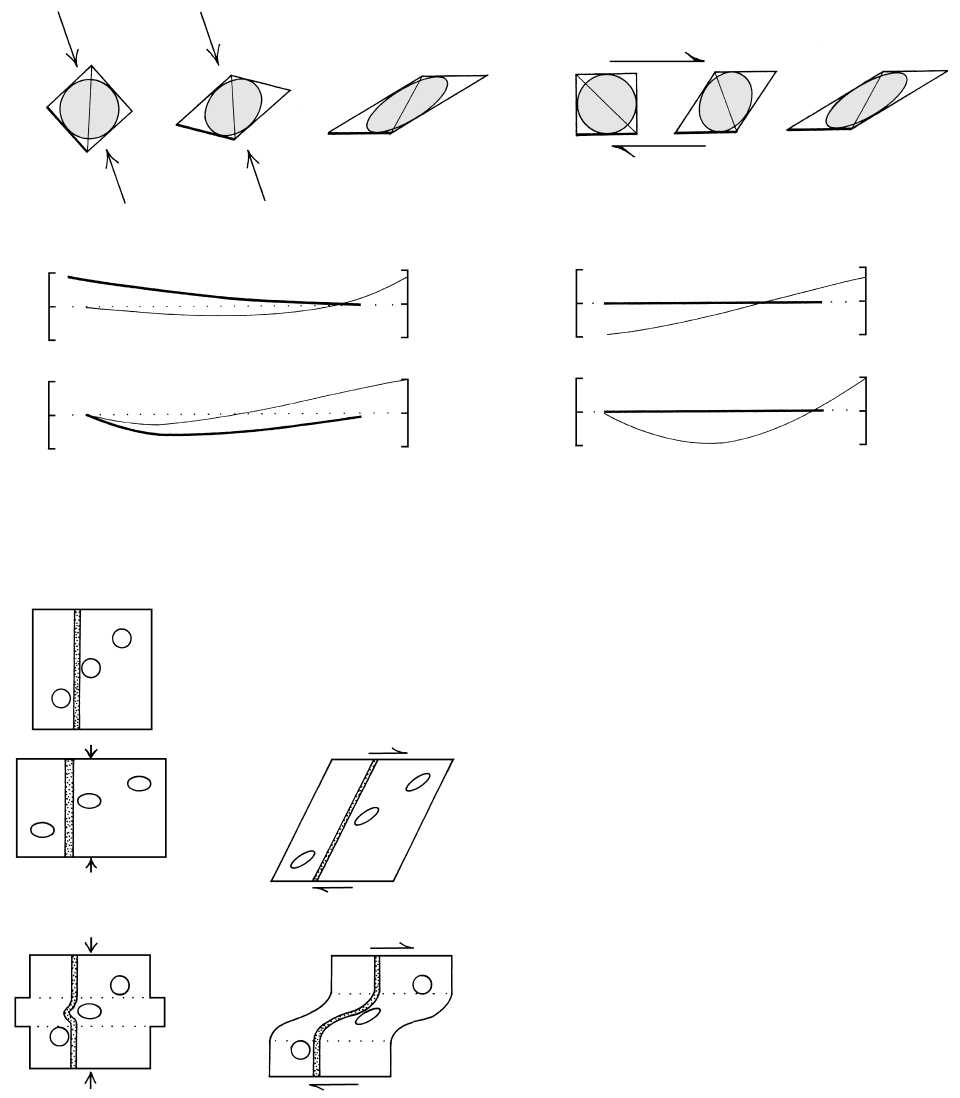
and twin systems to allow for considerable plasticity in
monomineralic aggregates (marble) over a wide range
of T, P, and strain rate. Although hexagonal quartz
has about as many slip systems as calcite, the Si–O
bonds are much stronger; consequently monomineralic
538 Igneous and Metamorphic Petrology
45°
0
45°
45°
0
45°
1
1
1
1
1
1
Line
rotation
Line
stretch
PURE SHEAR SIMPLE SHEAR
17.20 Contrast between progressive deformation by coaxial pure shear and noncoaxial simple shear. Plots in lower part of figure of rotation
and schematic stretching of thick and thin reference lines in deformed objects in upper part disclose different deformation paths for the
two styles of plane strain. Nonetheless, the final finite strain is identical. These models also conform to plane strain in that there are no
changes in their shapes perpendicular to the two-dimensional plane of the diagram.
Undeformed
Homogeneous
deformation
SIMPLE SHEAR
NONCOAXIAL DEFORMATION
Inhomogeneous
deformation
(strain
partitioning)
PURE SHEAR
COAXIAL DEFORMATION
17.21 Schematic contrasts between homogeneous deformation and
inhomogeneous deformation in pure and simple shear. Strain
ellipses could represent pebbles in a metaconglomerate and
band could represent a dike or vein.
aggregates of quartz (quartzite) are much stronger and
less easily strained plastically. Triclinic and monoclinic
feldspars in quartzo-feldspathic rocks are still less
plastic and their ductile strength is greater (Figure 8.8)
because of the paucity of slip systems. This contrast in
the ductility of the principal minerals in mylonitized
granitoids accounts for the typical porphyroclasts of
feldspar in the quartz-rich matrix (Figure 14.16c).
17.2.3 Crystal Defects
All real crystals are defective or imperfect to varying
degrees. Their lattices are never perfect arrays as com-
monly pictured, as for example in mineralogy text-
books. Nonrational boundaries of grains in aggregates
are one type of imperfection (Figure 6.9a). Other de-
fects lie within the crystal volume, distort the regular
periodicity of a lattice, introduce local strain, and
increase the internal stored elastic energy. Point de-
fects (Figure 6.5) lie near or at lattice points and are
essential for intracrystalline diffusion of ions through
the volume of a crystal. Line defects, more commonly
called dislocations, are responsible for the plasticity of
crystals and reduce plastic yield strengths. A disloca-
tion is not simply a linear collection of point defects,
but is instead a special category of irregularity that may
be visualized as a line in the slip plane separating
slipped from unslipped parts of the crystal. The nature
of dislocations and how they relate to slip are shown in
Figures 17.22 and 17.23.
In an ideally perfect crystal lacking dislocations, if
all the atoms along the entire slip plane were to be

moved simultaneously to a new equilibrium position,
considerable stress would be required to break all their
bonds with neighboring atoms. But slip in real crystals
by movement of dislocations requires far less shear
stress, about one thousand times smaller than theore-
tically predicted in perfect crystals, because only a line
of atoms needs to be moved at any instant and because
of the large number of possible dislocations. In real
crystals, slip nucleates in a small region of high stress
concentration and then spreads out in an expanding
loop across the slip plane until it ultimately intersects a
grain boundary where it produces a small step (Figure
17.23b). Propagation of an edge dislocation accompany-
ing slip through a stressed crystal has been likened to
the movement of a caterpillar, which humps up the rear
of its body by moving its tail forward, and then moves
the hump progressively forward to the head. Another
analogy is provided by the old parlor trick of how to
Evolution of Imposed Metamorphic Fabrics: Processes and Kinetics
539
Unstrained
(a)
Edge dislocation(b)
a
b
c
Extra
half plane
Completely
slipped crystal
Edge dislocation
atomic bond ac flips over to bc
Screw dislocation(c)
Completely
slipped crystal
Slip
plane
Screw
dislocation
a
b
c
17.22 Two types of dislocations. These are line defects on a slip plane (dark shaded) between sheared and unsheared crystal. (b) During
leftward (sinistral) shear of the top part of the crystal, the edge dislocation at the bottom edge of the extra half plane of lattice points
(light shaded) moves through the crystal by flipping atomic bonds. (c) During leftward tearing of the upper part of the crystal, a screw
dislocation moves from front to rear through the crystal.
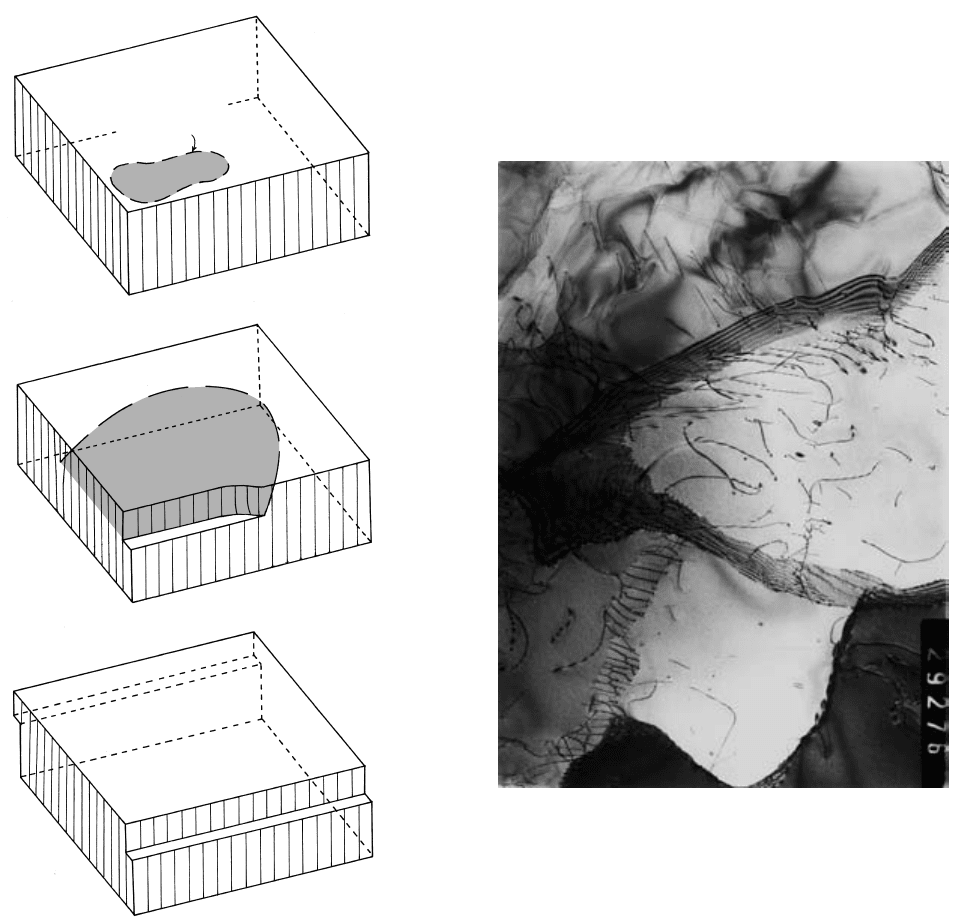
remove the carpet from a room without first taking out
all the heavy furniture, including the grand piano. The
easy way is to wrinkle up the carpet along one edge and
move the wrinkle across the room by lifting up corners
of furniture one at a time as necessary. This procedure
would have to be repeated numerous times to remove
the entire carpet from the room, but it does not require
much work (energy) at any instant. A screw dislocation
may be likened to tearing a sheet of paper, starting at
one edge and propagating the tear to the opposite edge.
Dislocations are thermodynamically unstable be-
cause they represent a local high energy region in a
crystal where the atomic bonds are elastically distorted.
But all crystals have them from the time of their
growth; they are built into the crystal from the begin-
ning, like the extra partial rows of kernels in some cobs
of corn. In undeformed crystals of quartz, the “den-
sity” of dislocations, expressed as the total length of
dislocation lines per volume, is about 10
3
cm/cm
3
(Fig-
ure 17.23d). Not only does shear stress cause existing
540 Igneous and Metamorphic Petrology
17.23 Dislocations in crystals. (a) Most dislocations in real crystals are not pure edge or screw dislocations but instead are of mixed character.
A dislocation loop nucleated within a nonhydrostatically stressed crystal propagates outward along the slip plane. (b) Along the front and
left side faces of the crystal block the loop is a pure screw and pure edge dislocation. (c) Completely slipped crystal showing offset step
along margin. Never at any time during the slip process is the crystal cleaved in two pieces; that is, it retains cohesion throughout the
plastic deformation. (d) Transmission electron micrograph of moderately strained quartz showing stringlike dislocations (line defects)
that are piled up at subgrain margins, the largest of which in right center is about 4 m across. Photograph courtesy of M. S. Weathers.
Dislocation
loop
Slip
plane
Completely
slipped crystal
(a)
(b)
(c)
(d)
dislocations to move, it also produces new ones at grain
boundaries, cracks, and other sources within the crys-
tal. Applied stress does work on the crystal, part of
which is stored as energy at newly created dislocations.
An intensely deformed quartz crystal, for example,
might contain 10
12
cm/cm
3
dislocations. As the dislo-
cation density increases during progressive deforma-
tion, greater shear stress is required to move interfering
piled up dislocations and to slip parts of the crystal that
have been effectively strengthened by the tangled dis-
locations. This phenomenon of continued plastic strain
requiring ever higher applied stress is called strain, or
work, hardening and can be seen in the stress–strain
curve for ductile behavior of real rocks and minerals
compared to the mathematical idealized plastic re-
sponse in Figure 8.3b.
17.2.4 Recovery during Dislocation Creep
At high temperatures above about 0.5 T
m
, where T
m
is
the melting T of the crystal in Kelvins, rates of atomic
diffusion become appreciable so that dislocations can
be mobilized, dislocation density reduced, and a more
stable, lower energy state attained by the crystal. This
recovery phenomenon counteracts work hardening
and allows for a more or less continuous deformation
to occur at more or less uniform applied nonhydrosta-
tic stress in what is called dislocation creep. The rate at
which new dislocations are generated in the stressed
crystal is approximately balanced by their elimination
in dislocation creep.
One recovery mechanism involves dislocation climb,
where an edge dislocation moves perpendicular to the
slip plane by the addition or removal of atoms, one at
a time, by diffusion along the edge of the extra half-
plane (Figure 17.24). Two dislocations of opposite sign
climbing toward each other are annihilated.
In other recovery processes, new grains are created
from pre-existing strained ones during deformation.
This can occur in two ways. In the first, climbing dislo-
cations of the same sign accumulate to form dislocation
walls lying at low angles to the less strained lattice on
either side. These walls define subgrains (Figures
17.18b and 17.25). Several subgrains are more stable
than a whole strained grain because the organized dis-
locations and lattice between them have lower energy.
Somewhat reoriented subgrains are responsible for
most of the undulatory extinction seen in strained sili-
cates under cross-polarized light in thin section. In the
second process of syntectonic, or dynamic, recrystal-
lization, dislocations in a segment of the margin of a
strained grain are mobilized and migrate to form small-
scale bulges that expand into adjacent grains, producing
irregular interlocking knobby outlines. New, small,
unstrained grains may also nucleate, initially along
margins of highly strained deformation bands and
ribbons, adding to the irregularity of the sutured grain
boundaries (Figures 17.26b and 15.17). Eventually,
small, unstrained polygonal grains may consume the
entire higher energy ribbon or subgrain (Figure 17.26c).
Thus, during dynamic recrystallization, deformation
is contemporaneous with recrystallization; as new
unstrained grains are created, they in turn become
deformed and are replaced by strain-free grains, and
so on. Very large amounts of strain become possible.
Dynamic recrystallization is especially evident in mylon-
ites developed in ductile shear zones.
With increasing magnitude of the shear stress, dis-
location density increases and the size of subgrains and
dynamically recrystallized grains decreases (Twiss and
Moores, 1992, p. 409; Snoke et al., 1998, p. 13). If the
magnitude of nonhydrostatic stress driving dislocation
creep increases, recovery processes will adjust to main-
tain a steady state by gathering the faster-forming
dislocations into more closely spaced subgrain walls;
the dislocations have a smaller distance to migrate
and the recovery rate is increased. Calibration against
experimentally deformed rocks suggests that stresses
on the order of 1 kbar are responsible for dynamically
recrystallized rocks in mylonitic ductile shear zones
(Figure 17.26). Dislocation creep produces significant
strain weakening in initially coarse-grained aggregates
and tends to partition strain (Figure 17.21) into finer-
grained zones that can evolve into mylonite (Snoke
et al., 1998, p. 13).
Recovery and recrystallization can continue after the
high-T grain aggregate has ceased to be deformed. This
annealing that can occur isothermally is driven by the
residual energy in the still strained grains and creates
new, strain-free polygonal grains with straight bound-
aries. In single-phase aggregates of minerals low in the
crystalloblastic series, such as quartz and feldspars,
grain boundaries meet at 120° triple junctions.
17.2.5 Hydrolytic Weakening of Silicates during
Plastic Slip
Widespread textural evidence of intracrystalline plastic
slip in silicate rock-forming minerals, especially quartz,
in tectonites had been observed for many decades,
but until the mid-1960s quartz had resisted plastic
deformation in the laboratory; in fact, it displayed
exceedingly large brittle strengths in excess of 20 kbar
at elevated P and T. This paradox was resolved when
D. T. Griggs and J. D. Blacic discovered the phenome-
non of hydrolytic weakening (Griggs, 1967) in quartz
crystals deformed in an apparatus (Figure 8.5) using
talc as a surrounding confining-pressure medium.
(At high T, the talc dehydrated and the liberated water
diffused into the deforming quartz, unlike in previous
experiments using “dry” pressure media). Subse-
quently, deformation experiments combined with opti-
cal and transmission electron microscopy and infrared
spectroscopy have been employed to investigate the
Evolution of Imposed Metamorphic Fabrics: Processes and Kinetics
541
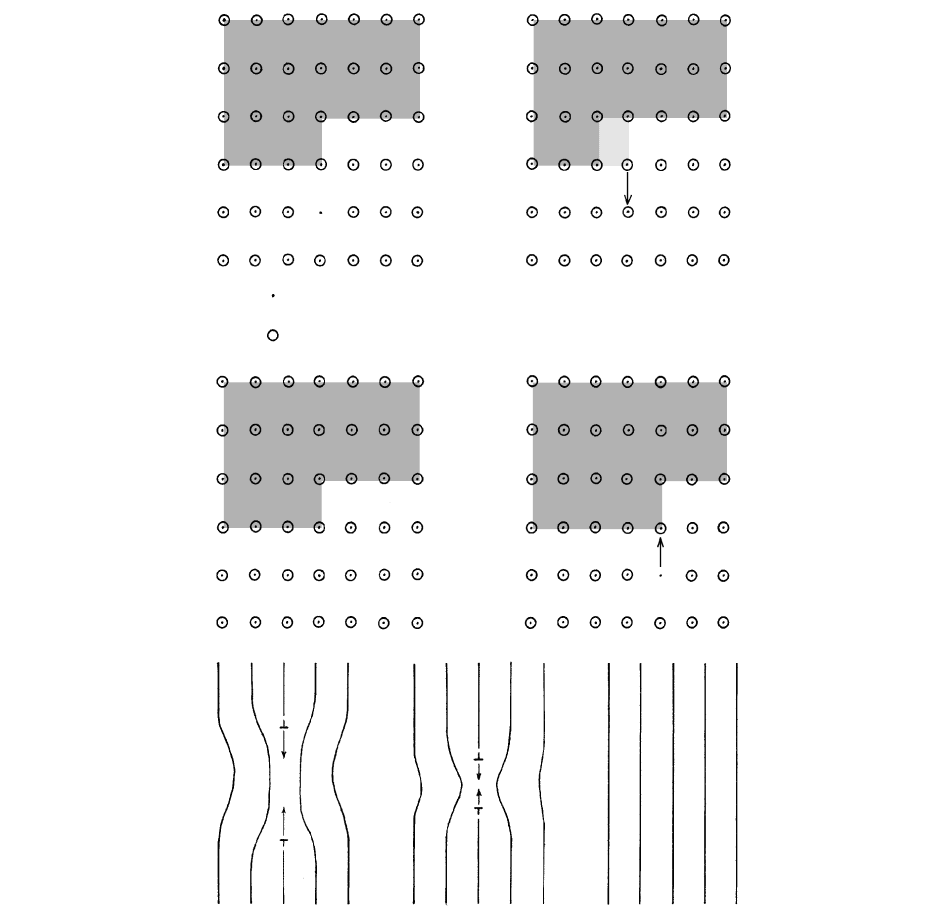
hydrolytic weakening phenomenon. Silicate minerals
such as quartz, feldspar, and olivine are nominally
anhydrous, but infrared spectroscopy reveals that
significant concentrations of water can be dissolved,
apparently in both molecular form and as (OH)
ions,
even under the high T and P that prevail in the mantle
(Section 11.2.1). Laboratory deformation of hydrous
quartz crystals containing as much as 0.13 wt.% H
2
O
(9000 H/10
6
Si atoms) occurs plastically above 400°C
at stress differences about an order of magnitude less
than required to deform dry quartz crystals. These
contrasts in strength are shown in Figure 8.8.
There has been considerable debate regarding ex-
actly how hydrolytic weakening takes place in “wet”
nonhydrostatically stressed silicates. The residence of
water may differ in deformed single quartz crystals
versus aggregates of grains. In quartzites, water can
exist as adsorbed molecules on grain boundaries and
as intergranular films and within individual grains in
aqueous fluid inclusions (Special Interest Box 16.3), as
structural water at defects, and bonded to Si and O
ions as H
and (OH)
ions. Post et al. (1996) found
the fugacity of water to be the most important fac-
tor controlling dislocation creep in quartzite and
542 Igneous and Metamorphic Petrology
Atom above extra half plane of atoms
Atom below
Extra
half
plane
(a)
(b)
(c)
17.24 Recovery by dislocation climb and annihilation. (a) Dislocation climb is accomplished by losses or gains of atoms one at a time by diffu-
sion along a jogged half plane edge. An atom from the edge of the extra half plane of atoms has diffused into a nearby vacancy, causing
the edge dislocation to climb upward. (b) The reverse occurs, extending the area of the half plane and causing the dislocation to climb
downward. (c) Two edge dislocations, now viewed from their ends, climbing toward one another are annihilated and the two extra half
planes become one whole. T symbolizes the end of an edge location. Redrawn from Nicolas and Poirer (1976).
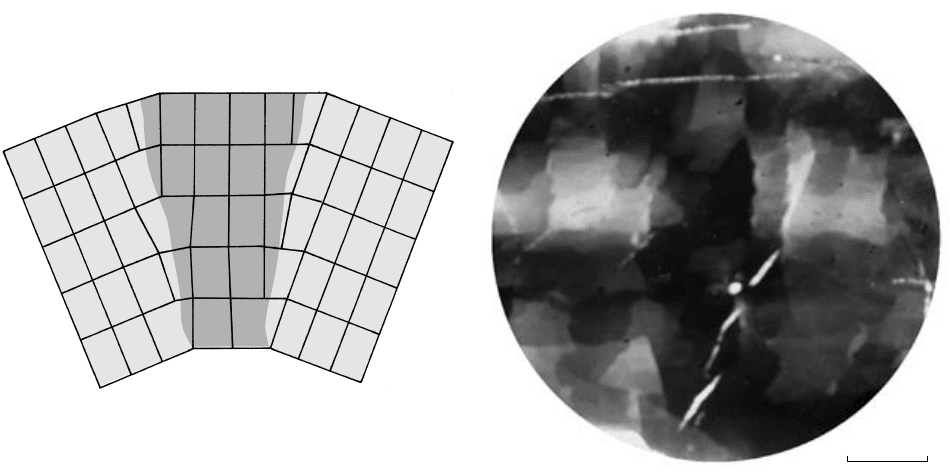
Evolution of Imposed Metamorphic Fabrics: Processes and Kinetics
543
(a)
(b)
0.010mm
17.25 Low-angle dislocation walls and subgrains. (a) Schematic of strained lattice with edge dislocations of the same sign (half planes all
extend in the same direction) concentrated into low-angle dislocation walls between three subgrains (shaded). Compare with bent
lattice in Figure 17.18 and with transmission electron photomicrograph of strained quartz grain that has dislocations accumulated along
subgrain margins (Figure 17.23d). (b) Photomicrograph of quartz subgrains viewed in cross-polarized light under a petrographic
microscope. (See also Figures 17.12b and 17.26a, b.)
fugacities of hydrogen and oxygen and hydrogen activ-
ity unimportant.
Locally higher water fugacities, perhaps related to
a passing front, or wave, of thermally induced dehy-
dration reactions, could weaken quartz-rich rocks and
allow partitioning of deformation into thin shear zones,
creating mylonite. Alternatively, dry, strong, high-grade
rocks might be invaded in some manner by aqueous
fluids that would hydrolytically weaken them and
allow focused deformation. In either case a change in
the state of stress or increasing stress magnitude is not
required to create the shear zone, only influx of water.
17.2.6 Power Law in Ductile Flow
Experiments on ductile flow of rocks by diffusive
transfer and plastic dislocation mechanisms in the
laboratory cannot exactly duplicate conditions in real
rock bodies because of the many variables existing in
geologic systems. One variable that is vastly different
is the time scale of deformation. Deformation in the
laboratory is accomplished over time periods of weeks
or, at most, months at strain rates, d/dt, of 10
7
/s.
But judging from rates of lithospheric plate movement,
strain rates in natural rock bodies are more likely to be
on the order of 10
12
–10
15
/s. In order to evaluate the
effects of these orders-of-magnitude slower strain rates,
the steady-state flow or creep seen in experimentally
deformed rocks and minerals is fitted to a exponential
rate equation, or power law (Paterson, 1987) of the
form
d/dt A
n
exp(E
a
/RT) 17.1
where A is the rate constant, is the stress difference
producing strain, n is a number between 2 and 8, E
a
is
the activation energy for steady-state flow, R is the gas
constant, and T is absolute temperature. A, n, and E
a
are empirical parameters that can be evaluated from
laboratory experiments (Twiss and Moores, 1992,
Chapter 18). Using this equation, the ductile strength
of rocks and minerals can be extrapolated through the
lithosphere for a geologically reasonable strain rate
(Figure 8.8). It is quite obvious that rocks at elevated P
and T in the lower crust and mantle that are strained
very slowly in a more or less viscous manner do so
under very small stress differences. Large nonhydrostatic
stresses cannot be sustained in these rocks.
17.3 INTERACTIONS BETWEEN
DEFORMATION, CRYSTALLIZATION,
AND FLUIDS IN TECTONITES
The previous two major sections examined recrystalliza-
tion and deformation as distinct and essentially separate
processes, as they may be in some metamorphic systems.
However, in the most widespread class of metamorphic
rocks and fabrics—tectonites and tectonite fabric—
these two processes were broadly contemporaneous.
Nonhydrostatic stresses have no direct bearing on
mineral equilibria (as once believed) but the magnitude
of these stresses in concert with strain rate, P, T, and
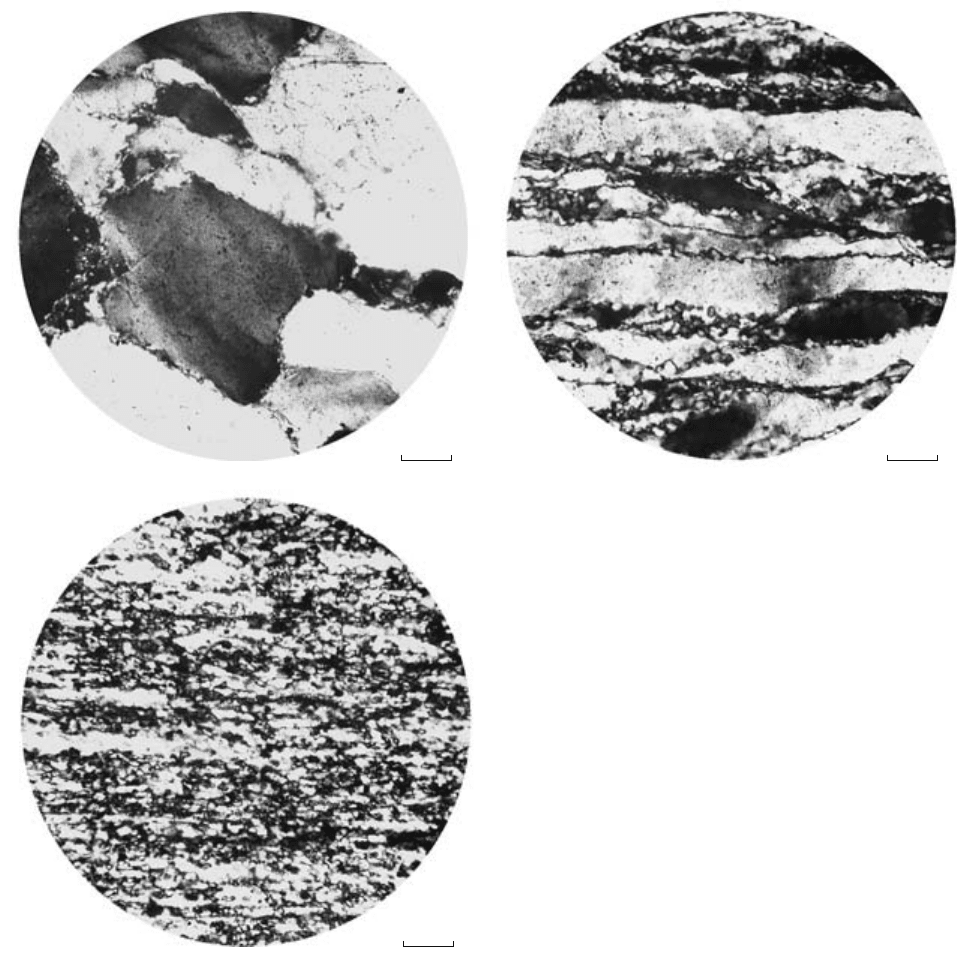
volatile fugacities during deformation can strongly
influence how—and even if—a rock recrystallizes. For
example, it is not unusual to find, in an otherwise
penetratively deformed metamorphic terrane, pods of
weakly or nondeformed rock (Figure 15.19) in which
a peak metamorphic mineral assemblage has not been
retrogressively overprinted or destroyed as in the sur-
rounding deformed rocks.
Interactions between deformation and recrystal-
lization can go both ways (Rutter and Brodie, 1995).
Deformation can enhance mineral reactions through:
1. Reducing grain size, increasing surface-area reactivity.
2. Increasing grain energy through work done on
grains, increasing dislocation density, thus making
grains less stable and more amenable to dissolution
in the presence of a fluid or to other modes of
breakdown with other reactants. Also, providing
high-energy sites for nucleation where dislocations
have migrated to grain margins.
3. Enhancing rock permeability in the intergranular
network and in hydraulic fractures (Holness, 1997).
Transient pressure gradients can be established by
opening and closing of cracks, driving fluid flow
(dilatancy pumping, Section 16.7.2). Moving fluids
not only catalyze mineral reactions but are essential
to their progress.
4. Increasing the T of the rock by shear heating (Sec-
tion 11.1.1).
544 Igneous and Metamorphic Petrology
(a)
0 0.1mm
(b)
0 0.1mm
0 0.1mm
17.26 Progressive mylonitization of the basal quartzite unit at the
Stack of Glencoul, Moine thrust zone, Scotland, viewed
under cross-polarized light. (a) Sample 110 m from the thrust
contact between quartzite and overlying Moine schist has
5% new recrystallized grains along margins of relict grains.
(b) Sample 5–10 m from the thrust contact has elongated rib-
bons (deformation bands) of highly plastically slipped quartz
grains that show undulatory extinction. Dynamic recrystalliza-
tion involving grain boundary migration has produced
knobby, or sutured, margins on quartz ribbons and local
domains of small polygonal grains that are essentially strain
free. (c) At the thrust contact, the quartzite is composed
almost entirely of dynamically recrystallized grains of about
the same size as in (b). For a discussion of the quartz-lattice
fabric in these mylonitic rocks see Law (1990). Photographs
courtesy of M. S. Weathers, from Weathers et al. (1979).
On the other hand, mineralogical factors can
influence deformation in the following ways:
1. Lower grade metamorphic rocks may be weaker
than higher grade. Phyllosilicates are weaker than
chemically equivalent, but volatile-free, assem-
blages of feldspars, pyroxenes, and so on. Rocks
rich in phyllosilicates, regardless of their grade, as
well as rocks that contain abundant carbonates and
quartz, can be weaker than feldspathic rocks.
2. Mineral composition governs the mode of ductile
deformation. Minerals generally more soluble in
the presence of fluids under metamorphic condi-
tions, such as carbonate minerals and quartz, are
more susceptible to pressure solution. Carbonate
minerals readily deform by twinning and disloca-
tion glide. Quartz is one of the more plastic min-
erals in rocks, whereas feldspars possess fewer slip
systems and do not readily deform plastically in
felsic rocks.
3. Most important, prograde devolatilization reac-
tions provide what is probably the major source of
fluids in the deeper continental crust. Fluids, espe-
cially water, are so important in fabric development
that their role is considered further in the following
section.
17.3.1 Role of Fluids in Tectonite Fabric
Development
Fluids are liberated throughout most of prograde
metamorphism up to granulite-facies conditions in vir-
tually all chemical rock groups. Pelites and hydrated
metabasites release water and calc–silicate rocks mixed
C–O–H fluids. The amount and fate of the liberated
volatiles depends on the depth (and P) at which the
devolatilization reactions occur, their nature, modal
composition of the rock, and its permeability. Small
amounts of fluid may only reside along grain edges and
corners but nonetheless could enhance diffusion and
pressure solution. Larger released amounts, especially
where produced by mixed-volatile fluid reactions in
calc–silicate rocks, can enhance intergranular perme-
ability and reduce the effective stress in the rock (Sec-
tion 8.2.1). This embrittles the rock, possibly creating
hydraulic fractures (Figure 8.2) that can be filled with
precipitates from the fluid, forming veins of various
mineral compositions. The effects of repeated cracking
and vein filling—the crack–seal process—is evident in
many veins (Passchier and Trouw, 1996, Chapter 6).
Reduced frictional resistance in fluid overpressured
shear zones may allow grain boundary sliding or even
cataclasis, resulting in dilatance and increase in perme-
ability (de Roo and Williams, 1990). These conduits for
advective flow allow solution transfer, metasomatic
alteration, and other fluid-related processes. If the
fluid eventually escapes from the rock system, ductile
conditions can be restored as T continues to rise in
dehydrated rocks. Veins formed by brittle fracturing
might become folded or otherwise deformed. These
changing metamorphic conditions can be viewed in a
spatial setting in Figure 17.27.
In some cases, undeformed masses of rock sur-
rounded by pervasively deformed rock (as cited above)
escape deformation because of restricted access of
water. Rock and mineral strengths are significantly
reduced in the presence of water (Figure 8.8). Higher
water fugacities promote hydrolytic weakening in
silicates and ductile flow that otherwise might not
happen by dislocation creep under a particular state of
stress.
17.3.2 Timing of Deformation and Crystallization:
Larger Scale Implications
Determination of the chronology of deformation and
crystallization during the development of tectonites is
of fundamental significance because of its bearing on
larger scale metamorphism and tectonism in the evolu-
tion of orogens. In tectonites, the effects of different
styles and orientations of deformation together with
the effects of mineral equilibration under different
metamorphic conditions are overprinted on one an-
other. Superposition of successive overprints may not
completely erase the effects of prior events in poly-
metamorphism so all are preserved to varying degrees
in the rock fabric and structure. Unraveling these
overprints and elucidating their chronology is a major
challenge, particularly when it comes to translating
fabric features into distinct episodes of tectonism and
heating/burial that shaped an evolving, continent-scale
orogen over tens or perhaps hundreds of millions of
years.
Establishing relative chronologies of deformation
and recrystallization in metamorphic rocks, our focus
in this section, depends on accurate reading and inter-
pretation of critical fabric elements corresponding to
different overprints. The next step, establishing an
absolute chronology using the tools of isotope geo-
chemistry, must be based on datable mineral grains,
but their time of growth or destruction relative to the
tectonism must be determined by the petrologist for
the age determinations to have any relevance in the
chronologic framework of the evolving orogen.
In an evolving single-cycle orogen, the major fabric-
forming deformation typically precedes, or is concur-
rent with, the peak thermally induced recrystallization
of the regionally metamorphosed rocks (Yardley,
1981). During heating as the peak metamorphism is
approached, dehydration mineral reactions promote
ductile deformation in the prevailing nonhydrostatic
stress field. Continuing recrystallization at the thermal
peak overprints, to varying degrees, even destroying,
features of the ductile deformation that occurred en
Evolution of Imposed Metamorphic Fabrics: Processes and Kinetics
545
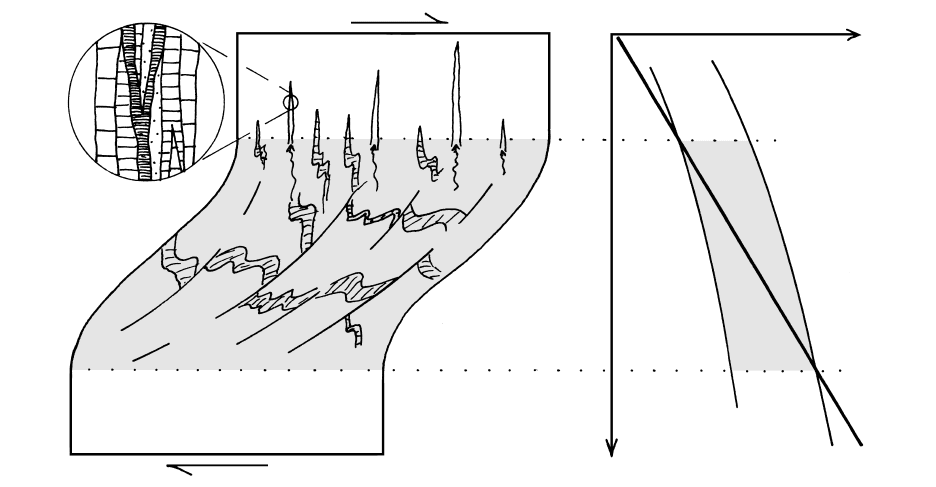
route. However, larger scale structures, such as folds,
boudinage, and coarse compositional layering, are typ-
ically larger than the sphere of diffusional transfer and
dislocation migration and so mostly escape oblitera-
tion. Once the metamorphic terrane has been largely
dewatered through prograde reactions, and may be
also cooling, pervasive ductile deformation of the
stronger rocks is limited, if not completely curtailed.
However, local retrograde metamorphism can occur
where fluids are introduced, perhaps initially along
fractures; accompanying hydrating mineral reactions
and the overall weakening effect of water on the rock
cause further strain to be focused or partitioned so as
to produce local ductile deformation in shear zones.
Before we attempt to deal with specific fabrics from
which relative timing can be determined, two caveats
should be pointed out. First, deformation in inhomo-
geneous anisotropic metamorphic rocks is itself inho-
mogeneous and, therefore, its expression depends on
the scale of observation. Strain partitioning can result
in contrasting expressions of tectonite fabric in differ-
ent domains of a rock (Figures 17.21 and 14.15). For
example, folia of phyllosilicates can generally accom-
modate more strain in a particular state of stress than
can neighboring quartzo-feldspathic layers, especially
if the latter are dry. Where there is a local influx of
water into initially dry rocks, for whatever reason, they
can be weakened. Because deformation can be specific
to particular mineral and modal compositions and fluid
conditions a particular tectonic episode may not be
recorded in all rocks.
Second, deformation–crystallization interactions
observable on the scale of a thin section may be
difficult to translate accurately to the larger scale of an
entire metamorphic terrane unless numerous samples
are examined carefully.
17.3.3 Pre-, Syn-, and Postkinematic Fabrics
There are three possibilities as to when recrystallization
takes place in relation to the time of deformation; it
may be prekinematic, synkinematic, or postkinematic.
(Some petrologists use the term tectonic rather than
kinematic in this context; however, differential move-
ment of rock masses, as in local shear zones, is certainly
a kinematic event but it may not correspond to a re-
gional tectonic event of significance throughout an
orogen.) Establishing which of these three chronolo-
gies applies in a metamorphic rock hinges on accurate
recognition of critical cross-cutting relations, over-
growths, and contrasts in expression and orientation in
its fabric (Passchier and Trouw, 1996).
Much of this critical chronologic record is preserved
in the pattern and types of mineral inclusions within
poikiloblasts relative to the texture of the matrix
surrounding them. As fruitful as these porphyroblast–
matrix relations can be, many provide no unambigu-
ous, single interpretation (Vernon, 1988). In addition,
a single thin section may not accurately portray the
546 Igneous and Metamorphic Petrology
Crack-seal
vein
Stronger, higher grade
rock
Hydraulic
fractures
Devolatilized
T
mineral
assemblage
Reactant
volatile-
bearing
mineral
assemblage
Ductile zone
Depth (P)
interval
Reaction
Geotherm
17.27 Strain partitioning into a 2–3 km thick interval of the stressed continental crust where release of volatile fluids from prograde mineral re-
actions has reduced the ductile strength. Fluids escaping upwards promote hydraulic fracturing and crack–seal vein formation,
featured in enlarged inset in upper left, involving successive fracturing and vein filling. As the crust is continually heated from below
the devolatilizing reactions progress upwards so that earlier planar veins emplaced under brittle conditions are overtaken and deformed
by the upward advancing ductile shear. Redrawn from Rutter and Brodie (1995).
